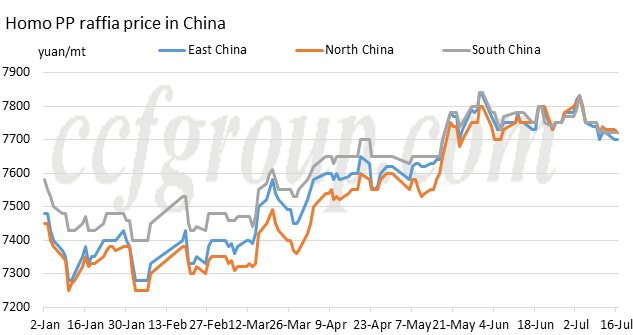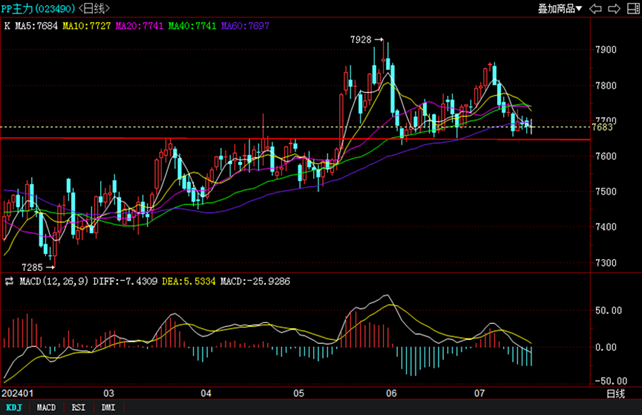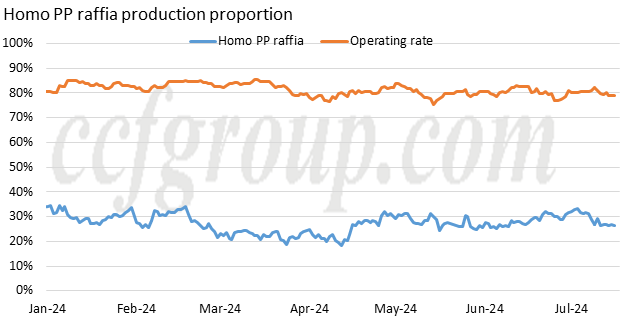Why PP market at a stalemate?
Since mid-July, after the downturn in the first ten days, PP market has entered a consolidation phase. As of Jul 17, mainstream traders offer for homo PP raffia at 7650-7750yuan/mt in East China; 7650-7750yuan/mt in North China and 7650-7780yuan/mt in South China. Solely based on prices, with the continuous release of production capacity in recent years, regional price differences are gradually disappearing. In the future, there is also a possibility of a reversal in regional trade flows.

The recent performance of spot prices is mainly based on the trend in futures. As a product with domestic production capacity exceeding 40 million tons/year and still in an expansion phase, the recent performance of PP futures can be considered disappointing. The intraday fluctuations are only around 40yuan/mt, and in early July, it even set the lowest volatility since the launch of PP futures on February 28, 2014 (25yuan/mt). Insufficient futures volatility leads to a dilemma for spot prices as well, with fluctuations making both prices rising and falling prices challenging.
|
PP2409 |
2024-7-10 |
2024-7-11 |
2024-7-12 |
2024-7-15 |
2024-7-16 |
|
Highest |
7723 |
7732 |
7713 |
7708 |
7704 |
|
Lowest |
7656 |
7670 |
7675 |
7666 |
7663 |
|
Change |
67 |
62 |
38 |
42 |
41 |
In addition to futures, weak downstream demand is also a major factor constraining spot prices. Currently, the downstream sector is in a traditional off-season atmosphere, with low buying interest and weak market mentality.
So, how will the market operate in the later period?
Firstly, from the perspective of PP futures, 7650yuan/mt is the current platform support level. Seeing from the trading logic based on fundamentals, the current market is weak in terms of supply and demand, and the unidirectional trend is unclear.

Furthermore, currently, PP futures shut for maintenance intensively, with some materials structurally tight, to a certain extent supporting the market. For example, the overall operating rate of PP is less than 80%, and the production proportion of homo PP raffia is maintained at around 26%-27% (daily output is about 33,000 tons). In the short term, in the latter half of July, there are not many planned maintenance activities for PP plants, and only a few small plants have scheduled restarts. This also means that, barring any unforeseen circumstances, in the latter half of July, PP supply may remain relatively stable, with supply variations of different grades being solely related to each company's production plans.

In the medium to long term, plants such as Shenhua Xinjiang, Sinopec Anqing Petrochemical, Zhongtian Hechuang, and Ningxia Baofeng III are planned to restart at the end of July or early August. It may have a certain impact on the market, as these plants primarily produce homo PP raffia and low-MFR co PP. In addition, the downstream off-season is expected to continue, and a sudden significant increase in demand is not very realistic. Coupled with the recent high temperatures, downstream operating rate may remain low, hindering market growth. As time progresses, supply-demand imbalances may become more pronounced.
In summary, it is likely that the market will remain volatile in the short term, with increasing pressure in the later period, potentially facing downward pressure.
- Top keywords
- Cotton Price
- Cotton Futures Price
- Cotton Futures
- CZCE
- PTA Futures Price
- Chemical Fiber
- Polyester Prices
- Wool price
- PTA Futures
- Shengze Silk
- China
- Yarn Price
- price
- China Textile City
- Fibre Price
- Benzene Price
- Cotton
- Index
- Cotton Index
- PTA
- fabric price
- NYMEX
- Top 10
- textile industry
- Spot Cotton
- Cotton Yarn
- Polyester Price
- Futures
- PTA Price
- cotton yarn price

